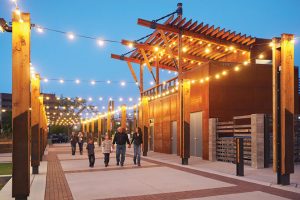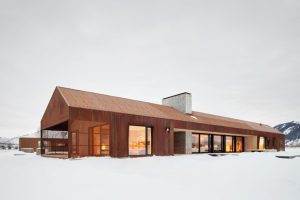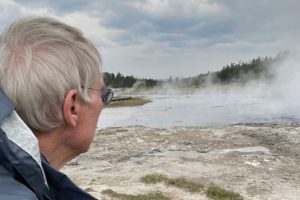Wyoming is no exception to the long line of leaders who’ve contributed to the longevity and success of the WMR.
As we look forward to 2022, we reflect on the journey we’ve all taken over these past couple of years. What was initially “optimism in the face of uncertainty” in February 2020 has now manifested a plethora of positive initiatives paving the road for our years ahead. Our organization’s difficult decisions over the past 18 months have equipped and enabled us for a potential future more beautiful than the one we left pre-pandemic. However, now is the time to rise and capture the opportunities presented to us, to be more than we ever have, to lead and design the future organizational model of the AIA. 2022 and beyond will be monumental!
As our national organization emerges from the grips of the pandemic, we’ve learned many lessons along the way as it relates to the potential and limitations of virtual work. In the virtual world, Zoom meetings are inexpensive, they’re emotionless and placeless most of the time, and we all have felt the fatigue associated with them. With all these negatives, the virtual world also presents us with positives. The possibility of a national organization that knows no boundaries – one more accessible and better represented in areas of geography than any we’ve had in the past. Now, as we begin to design the future of the AIA, hybridized working and service have come to the forefront. Let’s keep the positive attributes of the virtual world but also understand and accept its limitations. Let’s recognize that our BEST work is done together, in person, and be explicit regarding the value and importance of future in-person gatherings and meetings. Because our 2020 and 2021 boards have led our organization through these times with financial prudence, we’re emerging from this pandemic in a strong financial position and capable of accomplishing not only restructuring of meetings and travel but so much else as well.
We’re blazing the trail and are in the beginning stages of designing our new headquarters, the renewal of 1735 New York Avenue. The current building, designed by TAC in 1973, has served our profession exceedingly well for almost 50 years now, showing its age in relevance, function, and performance. This is a moment for us to look at ourselves in a mirror as an organization whose proclamations of taking a stand against climate change were authored in a building with a hobbling, non-renewable fueled mechanical system and not a bit of insulation anywhere in its walls or roof! Earlier this year, the board interviewed and selected the architect and general contractor for this project.
The selected architect, EHDD, and the builder, Turner Construction, have been working with the board and a smaller “Building Renewal Task Force” on initial concept development and cost for this project. Through this dialogue, we’re proposing that the new AIA headquarters be a tangible version of our values, a center for architectural advocacy and a membership common ground. It will be an exemplar of environmental stewardship, cultural equity, and inclusion that transcends its address in Washington, D.C., deep into every corner of our organization. EHDD is on target to have final schematic level work to the board by the end of January 2022.
In 2022, we will be welcoming a new EVP/CEO and offering a deeply deserved thank you and farewell to Robert Ivy. His leadership of the AIA has marked some of the most prosperous times of our organization. While his steady hand, profound knowledge, and unmistakably witty smile will be missed, we’re looking ahead to a new leader who, with our 2022 board and senior leadership team, will be tasked with designing an organization for the future.
To enable this forward-thinking work, two items of monumental nature occurred this year. First, the delegate members voted in June to establish the state-based model for the Strategic Council and other institute bodies. Secondly, through work with members responsible for two redacted resolutions, President Exley appointed the Members’ Voice Task Force to help better understand and improve the working and communication dynamics between the board of directors and national committees, including the Strategic Council as well as our local/state components.
With the vote moving our organization from regions to states, we anticipate increased efficiencies with member dues, enhanced advocacy efforts, and a more consistent member experience across the components. It will create a more direct, streamlined connection between the state components and national, allowing for more unified efforts and stronger communications. As an architect and volunteer leader very knowledgeable with the distant and remote nature of many of our western chapters, this change allows for an equal national representation across the broad geography of the AIA. All states now have a more equitable path for representation in national conversations, thereby increasing diversity of leadership and diversity of thought.
Our state and local components already exist as powerful hubs of influence and engagement. National can benefit from a more direct connection to that of states/local chapters. State components maintain staff, communicate strongly with members, wield influence on political, licensing, and other practice-related issues, collaborate with local components and sections within their state, promote design through design awards, and maintain active engagement with schools of architecture. Local components are vibrant hubs of member engagement, both in-person and digitally. Most produce hours of continuing education, wield influence in their communities on design, support local initiatives that improve their communities, offer mentoring programs, engage with local civic leaders, and promote design through design awards. Bringing these initiatives closer to National will bond the organization more tightly and provide agility to tackle future challenges.
Speaking as a former Director and passionate advocate of the Western Mountain Region, we’re now at the end of 62 years in dedicated service to our members, and 2021 is the last of a truly beautiful era. Wyoming is no exception to the long line of leaders who’ve contributed to the longevity and success of the WMR. For that, thank you to all who have selflessly given countless hours away from practices, families, and loved ones in the constant search for something greater. Those who’ve inspired others to rise in their footsteps; every current and former leader, every local chapter whose combined efforts built the greatness of the WMR. Now though, we’re tasked to seed the soil for what’s next, what’s better, what could be POSSIBLE! Through the MOU process, let’s design new opportunities for flexibility, collaboration, and prosperity, and encourage components to come together based on shared interests, issues, or concerns and not just because of geographic proximity. This can now include any state, any component, for any duration of time. Think of the possibilities!
This change could allow us to be our best, to do better than we have in the past. However, achieving this will require a commitment to one another, an active strategy to reach across state lines in recognition that we’re more TOGETHER than we are in separate state-defined silos. Think of the collective leadership energy presented to us in the territory of the former WMR alone: six strategic councilors rather than two, and six representatives each — up from just one — to the National Associates Committee, Young Architects Forum, and Small Firm Exchange. Together this change is propelling 24 new leaders into the national conversation from the current states of the WMR versus its current five; almost 400% greater representation.
So, with that, let’s capitalize on this opportunity and see what could manifest from this collective energy; let’s share in these roles and design this together to find the threshold of what could be possible. All while we remind each other that every project we do, every decision and every shift is a platform to make the world a better place.












